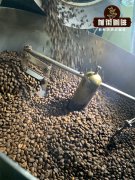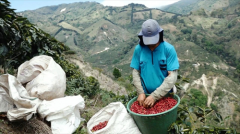Classic flavor of Costa Rican boutique coffee Costa Rica only grows Arabica coffee
The origin of Costa Rican coffee can be traced back to the introduction of Cuban coffee in 1729, and began to export coffee to Colombia and Chile in 1820, and shipped it to London in 1845, which was called golden beans by British aristocrats. In 1825, the Costa Rican government announced the implementation of a duty-free policy for coffee, and after 1832, it actively promoted the coffee industry and encouraged private farmers to grow coffee. to this day, most coffee farmers in Costa Rica are small coffee farmers who can handle coffee beans on their own. and trade with buyers everywhere.
Classical flavor
The coffee produced in Costa Rica is all high-quality Arabica coffee beans. In Costa Rica, the law stipulates that only Arabica coffee beans can be planted. It is illegal to grow Robska coffee beans. It is a very special legal provision in the world! But as a result, Costa Rican coffee is more distinctive, and its flavor is recognized as a perfect model in the coffee industry. it has a pure, mild and elegant taste, although the mellow thickness will vary slightly due to the altitude, but on the whole, the acidity is outstanding and smooth, the sweetness is rich but not greasy, the bitterness is rich but not astringent, and the tonality is very balanced and supple, which is the classic flavor of the world's boutique coffee!

The emerging unique honey treatment in Costa Rica
In the past, water washing was widely used in Costa Rica for processing, but in recent years, with the change of the trend, there has also been an original honey processing method created by Costa rica. the difference of this honey treatment is that it is improved by the half-sun method-the pectin layer is completely preserved and dried by the sun, making it more sweet and highlighting the sweetness of coffee. Thus it can be seen that the Costa Rican coffee technology, whether it is only cultivating Arabica coffee beans or creating a unique honey processing method, is very skillful, and most importantly, the coffee flavor is regarded as a classic in the boutique. Therefore, Costa Rica plays an important role in the world of boutique coffee, and there is no doubt about its high standard and top quality.
Important Notice :
前街咖啡 FrontStreet Coffee has moved to new addredd:
FrontStreet Coffee Address: 315,Donghua East Road,GuangZhou
Tel:020 38364473
- Prev

What kind of roasted coffee is not sour coffee beans what are the recommendations
The roasting process breaks down the acid in the coffee and releases more oil, resulting in a bitter taste. The longer the beans are baked or the higher the temperature is, the deeper the baking is, the more bitter the taste is. The beans produced by the darker coffee roasted are dark brown to black and look more greasy. Medium and deep baking is sometimes called Vienna or Full City, and in the dark range we have Italian baking (dark
- Next

Stonehenge Manor, Costa Rica blueberry coffee beans, anaerobic heavy honey treatment process.
Costa Rica introduced coffee beans from Cuba in 1729, and Costa Rica became the first country in Central America to grow coffee and the first to grow coffee because of its commercial value. Costa Rica is rich in volcanic soil, coupled with the influence of Pacific currents and monsoons, giving it a unique microclimate. Costa Rican boutique coffee growing areas have sufficient health.
Related
- Beginners will see the "Coffee pull flower" guide!
- What is the difference between ice blog purified milk and ordinary milk coffee?
- Why is the Philippines the largest producer of crops in Liberia?
- For coffee extraction, should the fine powder be retained?
- How does extracted espresso fill pressed powder? How much strength does it take to press the powder?
- How to make jasmine cold extract coffee? Is the jasmine + latte good?
- Will this little toy really make the coffee taste better? How does Lily Drip affect coffee extraction?
- Will the action of slapping the filter cup also affect coffee extraction?
- What's the difference between powder-to-water ratio and powder-to-liquid ratio?
- What is the Ethiopian local species? What does it have to do with Heirloom native species?

